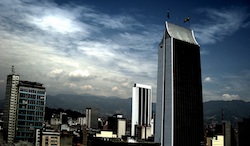While the official number of homicides hasn’t yet been released by authorities, the statistics available thus far indicate that conflict-ridden Colombia may have just registered its most peaceful year in decades. However, the data doesn’t tell the whole story.
According to police statistics accessed by El Tiempo, between January and December 1, 2014, Colombia saw over 11,600 murders. Added to more recent police figures showing 1,155 murders in the month of December, this means that Colombia finished 2014 with 12,776 homicides, El Tiempo reported. According to the newspaper, this is the most peaceful year Colombia has experienced since 1984 — the same year Medellin Cartel leader Pablo Escobar was arguably at the peak of his power, and ordered the murder of the country’s minister of justice.
That year saw just under 10,000 homicides. By 1991, Colombia’s homicide rate had climbed to a high of 78 murders for every 100,000 people — a total of 28,280 dead. In addition to the drug war, the conflict with guerrilla group the Revolutionary Armed Forces of Colombia (FARC) increased the violence. In 2002, the year President Alvaro Uribe took office, Colombia suffered from a homicide rate of 67 per 100,000.
Colombia’s police still haven’t released their official murder tally for 2014, and their count traditionally differs slightly from other Colombian agencies such as the forensic science institute, Medicina Legal, as the police do not count those who are wounded and later die as a result of their injuries.
Nevertheless, the overall trend is one of declining violence. Between 2012 and 2013, Colombia saw homicides drop by about nine percent, following a drop of about seven percent between 2011 and 2012. Feeding this phenomenon is the falling murder rate in cities like Medellin and Cali, both of which have seen homicides go down dramatically over the past year. There are still some exceptions to this trend across the country, including capital city Bogota, where violence is going up.
InSight Crime Analysis
One question is how much state and security force initiatives are driving these huge improvements in Colombia, and how much of the drop in violence is due to initiatives by illegal actors. A truce brokered in 2013 between Colombia’s largest criminal group, the Urabeños, and the descendants of the Medellin Cartel, known as the Oficina de Envigado, has undoubtedly contributed to Medellin’s tumbling murder rate.
In mid-2013, the Urabeños and the Oficina de Envigado decided that fighting was bad for the various illicit businesses based out of Medellin, from drug trafficking and gun running to extortion. After representatives of these criminal groups hashed out a deal in a luxury countryside house, the effect on Medellin’s security was palpable. The city reportedly registered just 653 murders in 2014 — its lowest in 35 years, and a stark contrast to the era of Pablo Escobar, when — at one point — the city saw 17 homicides a day.
SEE ALSO: Colombia News and Profiles
A similar criminal pact was reportedly brokered in Cali at the end of 2013. Colombia’s third-largest city has also seen violence fall: homicides dropped 23 percent between 2013 and 2014, the greatest decrease in two decades, according to Cali newspaper El Pais.
While it’s difficult to measure precisely how much these respective pacts have contributed to the falling national homicide rate in Colombia, it’s clear that this new wave of tranquility is fragile. Should these pacts break down and violence once again climb dramatically, Colombia could face the uncomfortable truth that its security may be more dependent on the interests of criminal actors as much as the actions of the state.
In 2014, Colombia reportedly arrested 1,894 members of what the government calls “BACRIM” groups (from the Spanish acronym for “criminal bands”), according to the Attorney General’s Office. As the chart below shows, just a fraction of these arrests involved public servants — those in the political and security sector who bolster the power of Colombian organized crime, and allow criminal structures to act with impunity. Should Colombia go after these officials rather than racking up arrests of gang foot soldiers, it would show that the state is very serious indeed about forging more durable peace and security conditions.


